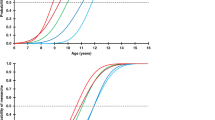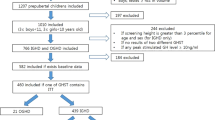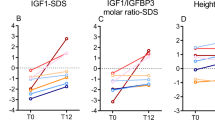Abstract
Insulin-like growth factor type 1 (IGF1) is a mediator of growth hormone (GH) action, and therefore, IGF1 is a candidate gene for recombinant human GH (rhGH) pharmacogenetics. Lower serum IGF1 levels were found in adults homozygous for 19 cytosine–adenosine (CA) repeats in the IGF1 promoter. The aim of this study was to evaluate the influence of (CA)n IGF1 polymorphism, alone or in combination with GH receptor (GHR)-exon 3 and −202 A/C insulin-like growth factor binding protein-3 (IGFBP3) polymorphisms, on the growth response to rhGH therapy in GH-deficient (GHD) patients. Eighty-four severe GHD patients were genotyped for (CA)n IGF1, −202 A/C IGFBP3 and GHR-exon 3 polymorphisms. Multiple linear regressions were performed to estimate the effect of each genotype, after adjustment for other influential factors. We assessed the influence of genotypes on the first year growth velocity (1st y GV) (n=84) and adult height standard deviation score (SDS) adjusted for target-height SDS (AH-TH SDS) after rhGH therapy (n=37). Homozygosity for the IGF1 19CA repeat allele was negatively correlated with 1st y GV (P=0.03) and AH-TH SDS (P=0.002) in multiple linear regression analysis. In conjunction with clinical factors, IGF1 and IGFBP3 genotypes explain 29% of the 1st y GV variability, whereas IGF1 and GHR polymorphisms explain 59% of final height-target-height SDS variability. We conclude that homozygosity for IGF1 (CA)19 allele is associated with less favorable short- and long-term growth outcomes after rhGH treatment in patients with severe GHD. Furthermore, this polymorphism exhibits a non-additive interaction with −202 A/C IGFBP3 genotype on the 1st y GV and with GHR-exon 3 genotype on adult height.
This is a preview of subscription content, access via your institution
Access options
Subscribe to this journal
Receive 6 print issues and online access
$259.00 per year
only $43.17 per issue
Buy this article
- Purchase on Springer Link
- Instant access to full article PDF
Prices may be subject to local taxes which are calculated during checkout



Similar content being viewed by others
References
Stochholm K, Gravholt CH, Laursen T, Jorgensen JO, Laurberg P, Andersen M et al. Incidence of GH deficiency—a nationwide study. Eur J Endocrinol 2006; 155: 61–71.
Wit JM, Kamp GA, Rikken B . Spontaneous growth and response to growth hormone treatment in children with growth hormone deficiency and idiopathic short stature. Pediatr Res 1996; 39: 295–302.
GH Research Society. Consensus guidelines for the diagnosis treatment of growth hormone (GH) deficiency in childhood adolescence: summary statement of the GH Research Society. J Clin Endocrinol Metab 2000; 85: 3990–3993.
Carel JC, Ecosse E, Nicolino M, Tauber M, Leger J, Cabrol S et al. Adult height after long term treatment with recombinant growth hormone for idiopathic isolated growth hormone deficiency: observational follow up study of the French population based registry. BMJ 2002; 325: 70.
Frisch H, Birnbacher R . Final height and pubertal development in children with growth hormone deficiency after long-term treatment. Horm Res 1995; 43: 132–134.
Ranke MB, Lindberg A, Chatelain P, Wilton P, Cutfield W, Albertsson-Wikland K et al. Derivation and validation of a mathematical model for predicting the response to exogenous recombinant human growth hormone (GH) in prepubertal children with idiopathic GH deficiency. KIGS International Board. Kabi Pharmacia International Growth Study. J Clin Endocrinol Metab 1999; 84: 1174–1183.
de Ridder MA, Stijnen T, Hokken-Koelega AC . Prediction of adult height in growth-hormone-treated children with growth hormone deficiency. J Clin Endocrinol Metab 2007; 92: 925–931.
Geffner ME, Dunger DB . Future directions: growth prediction models. Horm Res 2007; 68 (Suppl 5): 51–56.
Kristrom B, Wikland KA . Growth prediction models, concept and use. Horm Res 2002; 57 (Suppl 2): 66–70.
Wit JM . Optimizing growth hormone therapy in growth hormone deficient children: what to do in the absence of hard evidence? Commentary on Rachmiel et al.: final height in children with idiopathic growth hormone deficiency treated with a fixed dose of recombinant growth hormone (Horm Res 2007;68:236–243). Horm Res 2007; 68: 244–247.
Jorge AA, Marchisotti FG, Montenegro LR, Carvalho LR, Mendonca BB, Arnhold IJ . Growth hormone (GH) pharmacogenetics: influence of GH receptor exon 3 retention or deletion on first-year growth response and final height in patients with severe GH deficiency. J Clin Endocrinol Metab 2006; 91: 1076–1080.
Jorge AA, Arnhold IJ . Growth hormone receptor exon 3 isoforms and their implication in growth disorders and treatment. Horm Res 2009; 71 (Suppl 2): 55–63.
Wassenaar MJ, Dekkers OM, Pereira AM, Wit JM, Smit JW, Biermasz NR et al. Impact of the exon 3-deleted growth hormone (GH) receptor polymorphism on baseline height and the growth response to recombinant human GH therapy in GH-deficient (GHD) and non-GHD children with short stature: a systematic review and meta-analysis. J Clin Endocrinol Metab 2009; 94: 3721–3730.
Costalonga EF, Antonini SR, Guerra-Junior G, Mendonca BB, Arnhold IJ, Jorge AA . The −202 A allele of insulin-like growth factor binding protein-3 (IGFBP3) promoter polymorphism is associated with higher IGFBP-3 serum levels and better growth response to growth hormone treatment in patients with severe growth hormone deficiency. J Clin Endocrinol Metab 2009; 94: 588–595.
Ohlsson C, Mohan S, Sjogren K, Tivesten A, Isgaard J, Isaksson O et al. The role of liver-derived insulin-like growth factor-I. Endocr Rev 2009; 30: 494–535.
Harrela M, Koistinen H, Kaprio J, Lehtovirta M, Tuomilehto J, Eriksson J et al. Genetic and environmental components of interindividual variation in circulating levels of IGF-I, IGF-II, IGFBP-1, and IGFBP-3. J Clin Invest 1996; 98: 2612–2615.
Li HJ, Ji CY, Wang W, Hu YH . A twin study for serum leptin, soluble leptin receptor, and free insulin-like growth factor-I in pubertal females. J Clin Endocrinol Metab 2005; 90: 3659–3664.
Ester WA, Hokken-Koelega AC . Polymorphisms in the IGF1 and IGF1R genes and children born small for gestational age: results of large population studies. Best Pract Res Clin Endocrinol Metab 2008; 22: 415–431.
Frayling TM, Hattersley AT, McCarthy A, Holly J, Mitchell SM, Gloyn AL et al. A putative functional polymorphism in the IGF-I gene: association studies with type 2 diabetes, adult height, glucose tolerance, and fetal growth in UK Populations. Diabetes 2002; 51: 2313–2316.
Rosen CJ, Kurland ES, Vereault D, Adler RA, Rackoff PJ, Craig WY et al. Association between serum insulin growth factor-I (IGF-I) and a simple sequence repeat in IGF-I gene: implications for genetic studies of bone mineral density. J Clin Endocrinol Metab 1998; 83: 2286–2290.
Weber JL, May PE . Abundant class of human DNA polymorphisms which can be typed using the polymerase chain reaction. Am J Hum Genet 1989; 44: 388–396.
Silva EG, Slhessarenko N, Arnhold IJ, Batista MC, Estefan V, Osorio MG et al. GH values after clonidine stimulation measured by immunofluorometric assay in normal prepubertal children and GH-deficient patients. Horm Res 2003; 59: 229–233.
Rocha MG, Marchisotti FG, Osorio MG, Marui S, Carvalho LR, Jorge AA et al. High prevalence of pituitary magnetic resonance abnormalities and gene mutations in a cohort of Brazilian children with growth hormone deficiency and response to treatment. J Pediatr Endocrinol Metab 2008; 21: 673–680.
Tanner JM, Whitehouse RH, Takaishi M . Standards from birth to maturity for height, weight, height velocity, and weight velocity: British children, 1965. II. Arch Dis Child 1966; 41: 613–635.
Greulich WW, Pylc SI . Radiographic Atlas of Skeletal Development of the Hand and Wrist. Stanford University Press: Palo Alto, CA, 1959.
Arends N, Johnston L, Hokken-Koelega A, van Duijn C, de Ridder M, Savage M et al. Polymorphism in the IGF-I gene: clinical relevance for short children born small for gestational age (SGA). J Clin Endocrinol Metab 2002; 87: 2720.
Vaessen N, Heutink P, Janssen JA, Witteman JC, Testers L, Hofman A et al. A polymorphism in the gene for IGF-I: functional properties and risk for type 2 diabetes and myocardial infarction. Diabetes 2001; 50: 637–642.
Pantel J, Machinis K, Sobrier ML, Duquesnoy P, Goossens M, Amselem S . Species-specific alternative splice mimicry at the growth hormone receptor locus revealed by the lineage of retroelements during primate evolution. J Biol Chem 2000; 275: 18664–18669.
Jernstrom H, Deal C, Wilkin F, Chu W, Tao Y, Majeed N et al. Genetic and nongenetic factors associated with variation of plasma levels of insulin-like growth factor-I and insulin-like growth factor-binding protein-3 in healthy premenopausal women. Cancer Epidemiol Biomarkers Prev 2001; 10: 377–384.
Rietveld I, Janssen JA, Hofman A, Pols HA, van Duijn CM, Lamberts SW . A polymorphism in the IGF-I gene influences the age-related decline in circulating total IGF-I levels. Eur J Endocrinol 2003; 148: 171–175.
Cordell HJ . Genome-wide association studies: detecting gene–gene interactions that underlie human diseases. Nat Rev Genet 2009; 10: 392–404.
Li W, Reich J . A complete enumeration and classification of two-locus disease models. Hum Hered 2000; 50: 334–349.
van der Kaay DC, Hendriks AE, Ester WA, Leunissen RW, Willemsen RH, de Kort SW et al. Genetic and epigenetic variability in the gene for IGFBP-3 (IGFBP3): correlation with serum IGFBP-3 levels and growth in short children born small for gestational age. Growth Horm IGF Res 2009; 19: 198–205.
Clemmons DR . Commercial assays available for insulin-like growth factor I and their use in diagnosing growth hormone deficiency. Horm Res 2001; 55 (Suppl 2): 73–79.
Marchini J, Donnelly P, Cardon LR . Genome-wide strategies for detecting multiple loci that influence complex diseases. Nat Genet 2005; 37: 413–417.
Lettre G, Butler JL, Ardlie KG, Hirschhorn JN . Common genetic variation in eight genes of the GH/IGF1 axis does not contribute to adult height variation. Hum Genet 2007; 122: 129–139.
Acknowledgements
This work was supported by grants from Fundacao de Amparo a Pesquisa do Estado de Sao Paulo-FAPESP (05/04726-0 and 06/55763-5 to EFC) and from Conselho Nacional de Desenvolvimento Cientifico e Tecnologico-CNPq (301339/2008-9 to BBM; 300982/2009-7 to IJPA; 475870/2009-3 and 301477/2009-4 to AALJ).
Author information
Authors and Affiliations
Corresponding authors
Ethics declarations
Competing interests
The authors declare no conflict of interest.
Rights and permissions
About this article
Cite this article
Costalonga, E., Antonini, S., Guerra-Junior, G. et al. Growth hormone pharmacogenetics: the interactive effect of a microsatellite in the IGF1 promoter region with the GHR-exon 3 and −202 A/C IGFBP3 variants on treatment outcomes of children with severe GH deficiency. Pharmacogenomics J 12, 439–445 (2012). https://doi.org/10.1038/tpj.2011.13
Received:
Revised:
Accepted:
Published:
Issue Date:
DOI: https://doi.org/10.1038/tpj.2011.13
Keywords
This article is cited by
-
Pharmacogenomics applied to recombinant human growth hormone responses in children with short stature
Reviews in Endocrine and Metabolic Disorders (2021)
-
Predicting Response to Growth Hormone Treatment
The Indian Journal of Pediatrics (2012)



